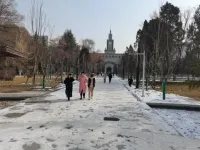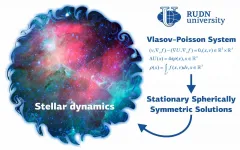(Press-News.org) URBANA, Ill. ¬- Mealtimes are a central aspect of family life, affecting the health and wellbeing of both children and adults. Although the benefits of healthy mealtimes are straightforward, helping all families realize those benefits is quite complicated, new research from University of Illinois shows.
The study highlights ways in which some solutions - such as an exclusive focus on improving food access or on improving mealtime preparation and organization skills - may be less effective if done in isolation, says Allen Barton, assistant professor in the Department of Human Development and Family Studies at U of I and lead author on the study.
"Family mealtimes are probably one of the most fundamental and frequent tasks that families engage in. If we are going to improve the health of children and families, effectively addressing family mealtimes will require some attention," he notes. "But in thinking about this issue we need to avoid overly simplistic answers and consider more holistic approaches to solutions."
Barton says previous studies on family mealtimes have tended to focus on either sociological factors (such as community food access and food security) or psychological factors (such as individual behaviors around mealtime activities) but the new study shows both dimensions are closely linked in families.
Barton and co-authors Brenda Koester, Elinor Fujimoto, and Barbara Fiese, researchers at U of I's Family Resiliency Center, studied more than 500 families with elementary school-aged children throughout the state of Illinois. Family members responded to a host of questions on food security, food planning and preparation, and mealtime organization. The researchers analyzed the data for patterns and identified three distinct groups, or family profiles.
The first profile, which comprised 55% of the sample, was characterized as food secure and having high levels of household organization. The families in this group reported the lowest levels of food insecurity and household chaos among the three profiles, as well as the highest levels of efficacy in preparing food, Barton says.
The second profile was at the opposite end of the spectrum and included 27% of the sample.
"This group not only reports they are food insecure, but they also report the lowest levels of confidence in preparing and planning meals and most difficulty in daily structure and routine in the home," Barton notes.
The third profile group, which comprised 18% of the sample, had food security levels that ranged between the other two groups, but they reported levels of meal planning efficacy and household chaos similar to families in the food secure group.
That food insecurity is co-occurring with other family risk patterns means efforts to promote healthy family mealtimes should address multiple aspects, Barton says.
"We need to ensure families have access to healthy food. But we also need to make sure individuals within the family feel competent to prepare and plan meals, and the day-to-day organization at home has some stability and routine," he states.
The researchers also identified specific differences among the groups in food preparation strategies and mealtime behaviors. In particular, families in the second profile (those with very low food security and more difficulty organizing daily tasks) reported fewer weekly meals together, higher technology use during meals, and greater usage of away-from-home food preparation strategies than families in the other groups. All these behaviors correlate with less healthy food consumption and outcomes, Barton says.
While the study found clear differences, there were also some similarities among the three groups. All of the families were equally likely to shop for food in a variety of stores, including grocery stores, discount stores, and big box stores. The researchers also found general agreement in most common challenges among families concerning household meals, including how to deal with picky eaters and wanting easy menu ideas.
"The findings from this study are important in helping us develop practical resources that families can use to address challenges they face in providing healthy meals and regular family mealtimes," Koester notes.
The research also provides information for policy makers to address structural issues around access to food, as well as suggestions for changes within the home.
"We need to understand risk is multifaceted, so we should avoid myopic answers and solutions. We need to address food insecurity. We also need to help individuals increase their confidence in preparing meals as well as building routines, predictability, and organization into life in the home," Barton states.
For families, Barton emphasizes the importance of prioritizing family mealtimes. "These mundane aspects of family life that may seem trivial are really formative. Think about one aspect that you want to improve in this area - whether it's having more healthy meals, less screen usage during meals, learning about different food banks, or just having more meals together during the week - and then develop a strategy to go about doing it. There are some tremendous resources, including ones created by the researchers and educators at the University of Illinois, available to help you and your family."
For families facing food insecurity, Illinois Extension has created a resource called Find Food IL, which provides localized information for access to food. For families with children, the Family Resiliency Center offers help with family routines and other strategies for building resilience, as well as a series of videos on mealtime challenges and a collection of healthy meal recipes.
INFORMATION:
The Department of Human Development and Family Studies is in the College of Agricultural, Consumer and Environmental Sciences, University of Illinois.
The article, "The complexities of family mealtimes in the 21st century: A latent profile analysis," is published in Appetite. Authors include Allen Barton, Brenda Koester, Elinor Fujimoto, and Barbara Fiese.
[https://doi.org/10.1016/j.appet.2020.105009]
Partial funding for this research was provided by the Christopher Family Foundation Food and Family Program.
Researchers from Kumamoto University (Japan) have clarified the mechanism by which blood and lymph vessels remain segregated from one another after development. The characteristics and structures of these two vessel types are very similar, and how they maintain separation has remained unexplained for many years. In this study, researchers found that the molecule Folliculin (FLCN) in vascular endothelial cells acts as a gatekeeper to maintain that separation.
Blood and lymphatic vessels form independent networks until the final confluence at the left and right venous angles in the neck. Blood vessels act as a pipeline that ...
We've all felt stressed at some point, whether in our personal or professional lives or in response to exceptional circumstances like the COVID-19 pandemic. But until now there has been no way to quantify stress levels in an objective manner.
That could soon change thanks to a small wearable sensor developed by engineers at EPFL's Nanoelectronic Devices Laboratory (Nanolab) and Xsensio. The device can be placed directly on a patient's skin and can continually measure the concentration of cortisol, the main stress biomarker, in the patient's sweat.
Cortisol: A double-edged sword
Cortisol is a steroid hormone ...
The group led by Dr. Enrique J. Calderón - "Clinical Epidemiology and Vascular Risk" at the Institute of Biomedicine of Seville - IBiS/University Hospitals Virgen del Rocío and Macarena/CSIC/University of Seville, also a member of CIBERESP, participated in a project with researchers from CIBER-BBN, in which they developed systems to detect Pneumocystis jirovecii, an atypical fungus responsible for very severe pneumonia in immunosuppressed patients. The results have been published in the journals Nanomaterials and Journal of Fungi, and are the fruit of collaboration with the CIBER-BBN groups led by Dr. Laura Lechuga, ...
The spinal column consists of 24 vertebrae that provide axial support to the torso and protection to the spinal cord that runs through its central cavity. The vertebrae are connected by means of intervertebral discs. These discs are highly hydrated, flexible and highly mechanically resistant. They allow the column its flexibility and act as shock absorbers during daily activities such as walking, running and in impact situations, such as jumping.
These unique features are made possible by the discs' tissue composition and structure. At its centre, there is a gel-like ...
At the time of writing, coronavirus disease 2019 (COVID-19) is seriously threatening human lives and health throughout the world. Before effective vaccines and specific drugs are developed, non-pharmacological interventions and numerical model predictions are essential. To this end, a group led by Professor Jianping Huang from Lanzhou University, China, developed the Global Prediction System of the COVID-19 Pandemic (GPCP).
Jianping Huang is a Professor in the College of Atmospheric Sciences and a Director of the Collaborative Innovation Center for Western Ecological Safety, Lanzhou University, China. He has for a long time been dedicated to studying ...
The Vlasov-Poisson equations describe many important physical phenomena such as the distribution of gravitating particles in the interstellar space, high-temperature plasma kinetics, and the Landau damping effect. A joint team of scientists from the Mathematical Institute of RUDN University and the Mathematical Institute of the University of Munich suggested a new method to obtain stationary solutions for a system of Vlasov-Poisson equations in a three-dimensional case. The obtained solutions describe the phenomena of stellar dynamics. The results of the study were published in the ...
Global greenhouse gas emissions over the last century have made southern China a hotspot for bat-borne coronaviruses, by driving growth of forest habitat favoured by bats.
A new study published today in the journal Science of the Total Environment provides the first evidence of a mechanism by which climate change could have played a direct role in the emergence of SARS-CoV-2, the virus that caused the COVID-19 pandemic.
The study has revealed large-scale changes in the type of vegetation in the southern Chinese Yunnan province, and adjacent regions in Myanmar and Laos, over the last century. Climatic changes ...
Neanderthals' gut microbiota already included some beneficial micro-organisms that are also found in our own intestine. An international research group led by the University of Bologna achieved this result by extracting and analysing ancient DNA from 50,000-year-old faecal sediments sampled at the archaeological site of El Salt, near Alicante (Spain).
Published in Communication Biology, their paper puts forward the hypothesis of the existence of ancestral components of human microbiota that have been living in the human gastrointestinal tract since before the separation between the Homo Sapiens and Neanderthals that occurred more than 700,000 years ago.
"These results allow us to understand which components of the human gut microbiota ...
New research has identified a nanostructure that improves the anode in lithium-ion batteries
Instead of using graphite for the anode, the researchers turned to silicon: a material that stores more charge but is susceptible to fracturing
The team made the silicon anode by depositing silicon atoms on top of metallic nanoparticles
The resulting nanostructure formed arches, increasing the strength and structural integrity of the anode
Electrochemical tests showed the lithium-ion batteries with the improved silicon anodes had a higher charge capacity and longer lifespan
New research conducted by the Okinawa Institute of Science and Technology ...
USC researchers have developed a new method to counter emergent mutations of the coronavirus and hasten vaccine development to stop the pathogen responsible for killing thousands of people and ruining the economy.
Using artificial intelligence (AI), the research team at the USC Viterbi School of Engineering developed a method to speed the analysis of vaccines and zero in on the best potential preventive medical therapy.
The method is easily adaptable to analyze potential mutations of the virus, ensuring the best possible vaccines are quickly identified -- solutions that give ...





